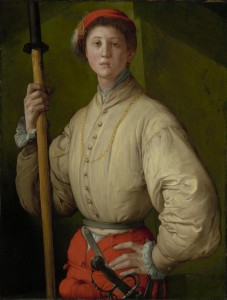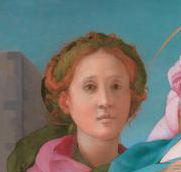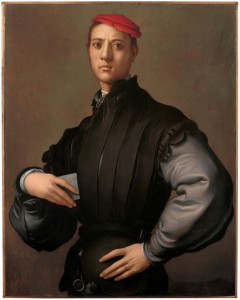Cultural Cocktail Hour
“Pontormo: Miraculous Encounters”- A MUST SEE exhibit at the Getty Center
“Pontormo: Miraculous Encounters”
A MUST SEE Exhibit at the Getty Center
By
Leticia Marie Sanchez
Organized by the Getty Museum in conjunction with the Gallerie degli Uffizi in Florence and the Morgan Library and Museum in New York, “Pontormo: Miraculous Encounters” is curated by Getty Museum Senior Curator of Paintings, Davide Gasparotto and Bruce Edelstein, coordinator of graduate programs and advanced research at NYU Florence.
The paintings and drawings presented in the exhibition were created by Jacopo Pontormo between 1528 and 1530, during an intense historical period. Battles between Florentine Republican forces and the Medici family in 1527 resulted in a siege. Incredibly, all three Pontormo paintings in the exhibit were painted during this tumultuous time, when Mannerist painter Jacopo Pontormo bravely remained in Florence to guard his home.
The opportunity to see the Visitation is somewhat of a miracle, not only because it’s the first time this riveting painting has left Italy, but more importantly because it was considered, according to Getty Director Timothy Potts “lost to the world,” until it was discovered within the last century.
The theme of the exhibit, “Miraculous Encounters” not only alludes to the miraculous meeting between the pregnant Virgin Mary and Saint Elizabeth in the “Visitation,” it also refers to a dialogue between drawings and painting by Pontormo and his pupil Bronzino.
The exhibit includes:
The Visitation by Jacopo Pontormo

Pontormo’s Visitation utterly captivates, holding the viewer spellbound with its expressionistic color and serenely moving subject. More than six feet tall, the painting depicts Mary’s meeting with her cousin, Saint Elizabeth, when both were pregnant. As patrician women, they are both accompanied by female attendants of the same age. When observing the painting, compare and contrast the rigidity of the architecture and the stoic mien of the female attendants with the dynamic, electric fluidity of Mary and Elizabeth. Vibrant flowing robes conceal epic, Biblical heroes waiting to be born: Jesus Christ and John the Baptist. Despite cloudy skies overheard warning of impending tempests, the strength of Mary and Elizabeth’s gaze is firm and unbroken. Similarly, by prolifically painting masterpieces during a historic siege, when the walls of his own city were being destroyed, the painter Pontormo himself embodied resilience.
Visitation, about 1528 – 1529, Pontormo, oil on wood panel. Parrocchia di San Michele Arcangelo a Carmignano (Prato). Image: Su concessione della Soprintendenza Archeologia, Belle Arti e Paesaggio per la Città Metropolitana di Firenze e per le Province di Pistoia e Prato. Photo © Antonio Quattrone, Florence
Cultural Cocktail Hour Trivia: Did you you know that the painting was commissioned by Bartollomeo Pinadori, a merchant of art supplies, particularly pigments? This explains why, even for a painting of its time, the colors are exceptionally resplendent.

- Who are the two mysterious tiny figures at the bottom left of the panel? Bruce Edelstein suggests that they are Zacharias and Joseph, the husbands of Elizabeth and Mary.
- Edelstein also revealed that Michelangelo saw Pontormo as his successor; Pontormo was considered the greatest living painter in Florence.
Indeed, the rich orange hued folds of Elizabeth’s robe evokes Michelangelo’s Delphic Sibyl in the Sistine Chapel.

Portrait of a Halberdier (Francesco Guardi?)
Dr. Gasparotto called the Portrait of a Halberdier a “glory” of the Getty’s permanent collection.
When observing the painting, note the medallion in this young man’s cap. The medallion contains the image of Heracles, a symbol of Florence. Just as the statue of David symbolized the power of the Florentines to vanquish powerful adversaries, Heracles also epitomized the intrepid spirit of the Florentines during this epoch of military strife.
Portrait of a Halberdier (Francesco Guardi?), about 1529 – 1530, Pontormo, oil on canvas (transferred from wood panel). The J. Paul Getty Museum

Another aspect to note is the uncanny similarity between face of the Halberdier and the face of one of the female attendants in the Visitation.

Portrait of a Young Man in a Red Cap (Carlo Neroni?)
Pontormo’s painting depicts Carlo Neroni, a volunteer in the army for the Florentine Republic. In his hands, this serious young man holds a letter. What does the letter represent? Is it a love letter? Is it a secret political letter? The only clue that we have are the few letters visible on the letter “Dom”- which could refer to a lord or to a house. Yet another file for the Art Mysteries!
Jacopo da Pontormo (1494-1557).Portrait of a Young Man in a Red Cap (Carlo Neroni?) ca. 1530, oil on panel. Collection of Mr. and Mrs. Tomilson Hill. Photo Courtesy of Shepherd Conservation, London













